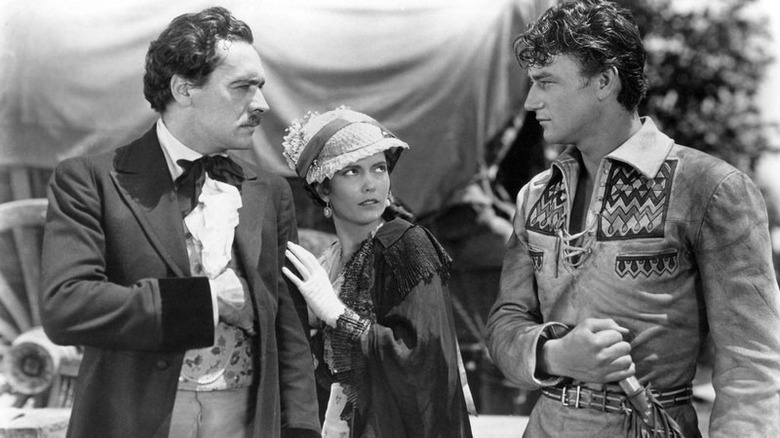Cutting-Edge Camera Tech (And The Depression) Doomed John Wayne's The Big Trail
The John Wayne his fans know and love didn't really show up until John Ford's "Stagecoach" in 1939. Though the director and silent Western star Tom Mix saw tremendous potential in the USC football washout when they took him on as a prop boy in the mid-1920s, his screen presence was purely physical. At 6'4", the Iowa-born lad cut a formidable figure on the big screen, but he had miles to go as an actor. If you asked Ford (and many did), he was happy to tell you that Wayne needed a decade's worth of seasoning in Poverty Row Westerns before he could topline a major Hollywood production.
It was unwise to argue with the cantankerous Ford, but Wayne had a shot at undermining his mentor when Raoul Walsh cast the young man as the star of 1930's "The Big Trail," an early, wildly pricey epic that sought to revolutionize motion-picture exhibition at the very moment movie houses were haphazardly adjusting to the sound era. It was an ambitious undertaking on every level, and it fell short on almost every one of them due to exhibitors' limitations. You could make a cinematic extravaganza like "The Big Trail," but could you screen it?
Too much innovation, too soon
In a 1976 interview with legendary, Texas-based TV reporter Bobbie Wygant (who'll turn 97 this November) timed to the release of Wayne's swan song, "The Shootist," the Duke wistfully recalled the debacle that, fortunately, bombed due to the technical limitations of the era.
"The Big Trail" was the first film to be shot and released in 70mm (via a branded process called "Fox Grandeur"), and while it was an immersive marvel when projected in filmed format, there were very few theaters in the United States that could deliver the spectacle as Walsh intended. As Wayne told Wygant:
"[I]t required the theater to put in a new screen and all new equipment in the projection room in those days because they hadn't invented the squeeze lens for the wide film. So, as a consequence, I guess maybe 10 theaters in the country played it because it was right in the middle of the depression. They were breaking up the furniture out in the streets and building the fires and selling the apples. It got off to a bad start."
There was a 35mm version of "The Big Trail" shot concurrently with the Grandeur variation, but it was, by most critical accounts, shorter and visually unimpressive (the former ran 108 minutes, while the latter clocked in at 122 minutes). 20th Century Fox released the restored Grandeur cut to Blu-ray in 2012, and while it is visually astonishing, the film's failure did Wayne a huge favor. As Dave Kehr noted in 1988, "The Big Trail" belongs to Raoul Walsh. The narrative takes a backseat to the director's pioneering widescreen splendor. Wayne wouldn't put it together until he cocked a Winchester rifle with one arm in "Stagecoach."

